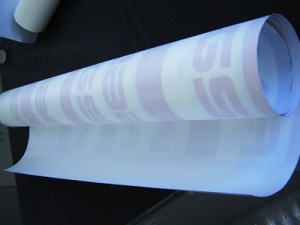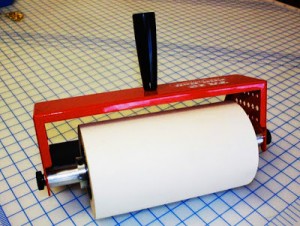Tunneling of the application tape off of the release liner can cause sign makers headaches – especially when the graphics are rolled and shipped to a customer across the country. Here’s the problem. If the tape tunnels on the release liner, it can travel over the graphic. When this happens, it is virtually impossible for the customer to reapply the tape so that it is flat again against the vinyl graphic without causing a wrinkle.
At RTape we have tried to minimize tunneling by developing our Conform® Series of application tapes. The Conform® products feature RLA® Release Liner Adhesion, which allow these application tapes to stick to slick release liners.

The development of the RLA® adhesive additive reduced the problem of tunneling.
With the development of the RLA® adhesive additive, the problem of tunneling was reduced, even when graphics are rolled. Note that I said “reduced” and not “eliminated”. Puckering and tunneling of the application tape over the surface of the release liner and graphic can still occur for a number of reasons.
Among these reasons, humidity can certainly contribute to application tape problems. This is especially the case, if the graphics were fabricated in an air conditioned environment, where the humidity is low, then taken outside, where the humidity in the summer air is high. The moisture in the air condenses on the cold surface of the application paper, just as moisture condenses on the outside of a glass containing a cold, refreshing adult beverage. As the application paper absorbs the moisture, it grows at such a rate that it pulls away from the release liner. When this happens, no amount of RLA® additive will allow the tape to lay flat on the liner.
The biggest factor in tunneling is mechanical stress. In the lamination process, you need to take care to avoid stretching the application tape. Stretched tape usually shrinks, causing tunnels as well as causing the vinyl graphic to curl.
The best way to apply application tape is with a laminator. This is how fleet graphics screen printers premask their graphics. And it’s the reason that they rarely have tape issues such as tunneling. If you can afford one, a laminator is a worthwhile investment for your shop. If the laminator is set up properly, you will apply application tape to graphics with a minimum of wrinkles, bubbles and tunneling. Equally important is that you will apply the application tape with low mechanical stress.
If your laminator has a heated roller, applying a little heat (100⁰F or 38⁰C) when laminating the tape to the graphic can cause the adhesive on the application tape to flow out better and create a better bond to the graphic. This can also help reduce the problems of a tape lifting off the surface of the graphic and creating a tunnel.
The next best alternative is to buy some type of application tape dispensing system. I have several. These include the WEBERmade tape dispenser and the ProRoll Application Tape Roller from Image One Impact.
The WEBERmade system bolts right on to your workbench with a couple of clamps. What I like about the machine is that it has a clutch or tension control knob, which allows you to adjust the unwind tension of the roll. Be careful, though. If you over-tighten the unwind tension, you can stretch the application tape as you laminate it to the cut vinyl graphics. What happens next is that the tape wants to stretch back to its original shape. As this happens, the application tape pulls away from the liner. If you look at the picture below, all of the tunnels, which have formed, are all across the web. This suggests stretching and contraction in the web direction.

Humidity and mechanical stress are two possible causes of puckering and tunneling.
The ProRoll Application Tape Roller works differently. It is a handheld device that allows you to simply roll the application tape over your graphics. Tape is applied to the vinyl graphics smoothly, with very low mechanical stress. And that reduces the likelihood of tunnels and curling graphics.

The ProRoll Application Tape Roller from Image One Impact.
One final word. If you are having problems with your application tape, call you sign supply distributor. You can also call RTape direct at 800-440-1250 or 908- We will make every effort to answer your questions quickly and efficiently.


